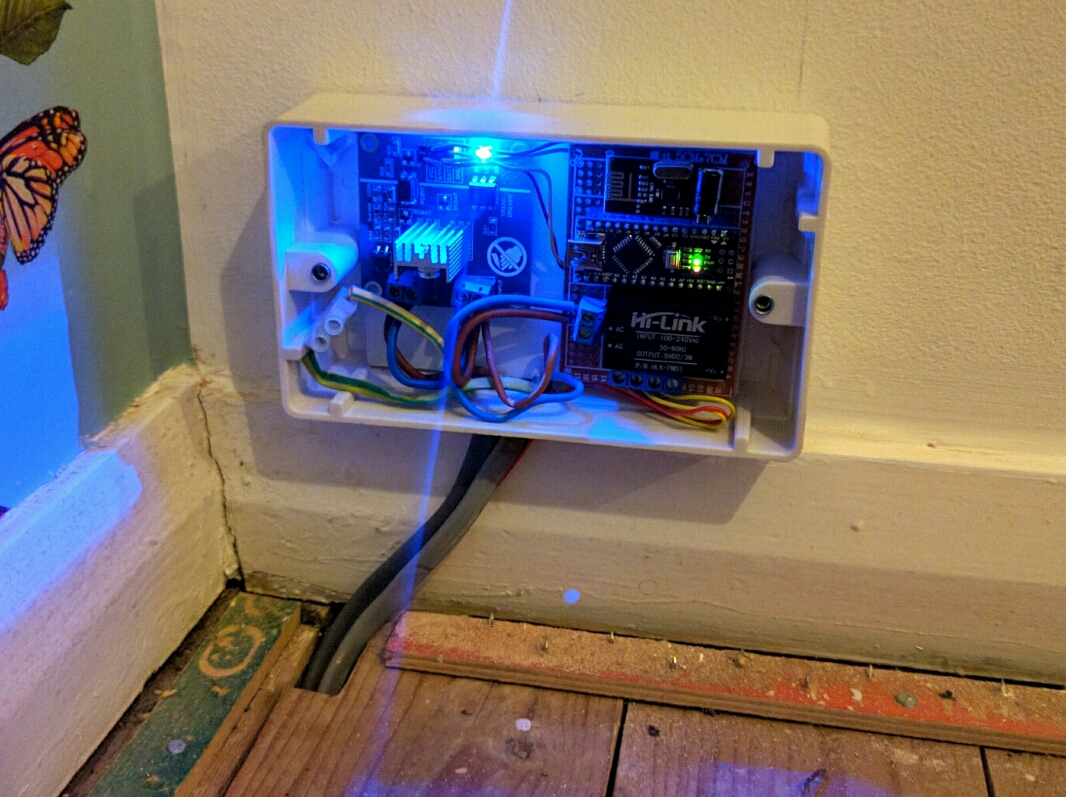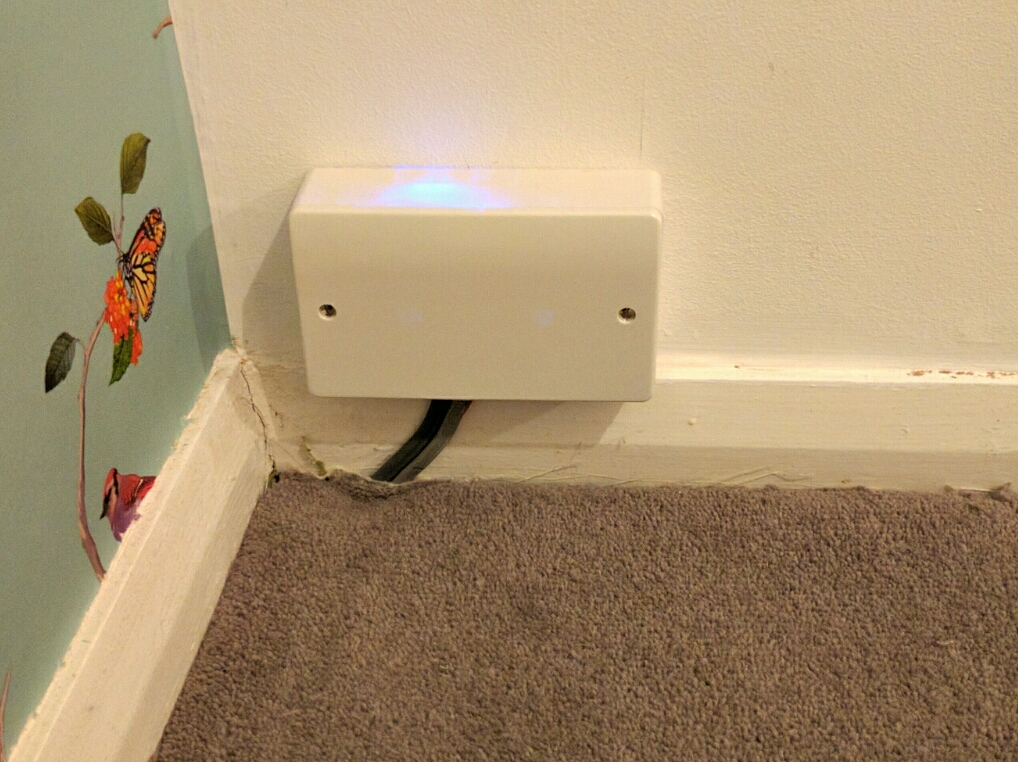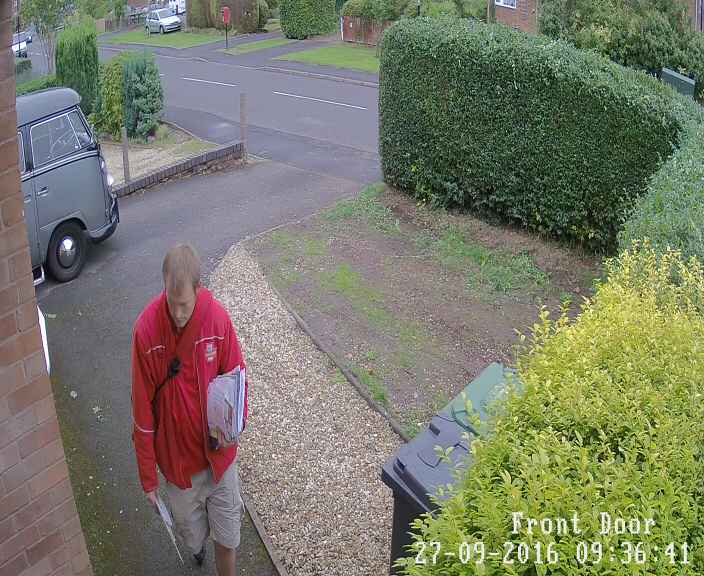Motion controlled dimmable LED porch light
-
Hi all,
Just wanted to show you all my motion-activated LED Porch Light. Lots of 12v LED lights on here, not so many mains AC-powered bulb projects, so I thought I'd show you mine. Sketch is a standard motion sensor interrupt sketch alongside a dimming sketch, I'm sure I got it from the forums. Initially I wanted it to perform local control of the lamp via the PIR but then decided I wanted the light to come on low (33%) from dusk till dawn, and then raise to 100% when it detects motion. Because of that I've left the control logic to Vera. Below about 30% the bulb shows an obvious unstable flicker so I don't go there! Dimming and ramp up/down is beautifully smooth.
It consists of:
Arduino Nano
NRF24L01 radio
HLK-PM01 240v AC>5v DC
HC-SR501 (PIR)
240v AC Phase control dimming circuit: http://www.ebay.com/itm/111764492631
4w dimmable filament LED bulb
Wall box with blanking plate

-
Hi all,
Just wanted to show you all my motion-activated LED Porch Light. Lots of 12v LED lights on here, not so many mains AC-powered bulb projects, so I thought I'd show you mine. Sketch is a standard motion sensor interrupt sketch alongside a dimming sketch, I'm sure I got it from the forums. Initially I wanted it to perform local control of the lamp via the PIR but then decided I wanted the light to come on low (33%) from dusk till dawn, and then raise to 100% when it detects motion. Because of that I've left the control logic to Vera. Below about 30% the bulb shows an obvious unstable flicker so I don't go there! Dimming and ramp up/down is beautifully smooth.
It consists of:
Arduino Nano
NRF24L01 radio
HLK-PM01 240v AC>5v DC
HC-SR501 (PIR)
240v AC Phase control dimming circuit: http://www.ebay.com/itm/111764492631
4w dimmable filament LED bulb
Wall box with blanking plate

-
@pjblink what a great project perfect for my needs.
Can you post the sketch please
Thanks Doug@5546dug Hi Doug,
Here you go. Annoyingly my PIR seems to have died after a week or so. Hoping it's a faulty unit rather than anything to do with the circuit. I've ordered another, and will see how it holds up. It seems i can trigger it by touching the unit in places, but the PIR sensor itself is dead and not detecting anything.
/* AC Light Control Uses up and down buttons to set levels makes use of a timer interrupt to set the level of dimming */ #include <SPI.h> #include <MySensor.h> #include <TimerOne.h> #define SN "AC LED Porch Dimmer Control" #define SV "1.3" #define NODE_ID 30 //change to a number to assign a specific ID #define FADE_DELAY 20 // Delay in ms for each percentage fade up/down (10ms = 1s full-range dim) #define MOTION_CHILD 1 //ID of the motion sensor child #define MOTION_PIN 2 // Arduino pin tied to trigger pin on the motion sensor. volatile int i=0; // Variable to use as a counter of dimming steps. It is volatile since it is passed between interrupts volatile boolean zero_cross=0; // Flag to indicate we have crossed zero int AC_pin = 7; // Output to Opto Triac int freqStep = 75; // This is the delay-per-brightness step in microseconds. It allows for 128 steps // If using 60 Hz grid frequency set this to 65 MySensor gw; //dimming static int currentLevel = 128; // Current dim level... uint8_t fadeLevel = 128; //used to store the fade level when using the buttons //motion sensor uint8_t lastMotion = 0; unsigned long previousMillis = 0; // last time update //see http://stackoverflow.com/questions/10773425/performing-a-function-after-x-time for more details on this unsigned long motionDelay = 10000; // interval at which to keep motion sensor trippped (milliseconds). Used to prevent too frequent updates to Vera. boolean metric = true; MyMessage dimmerMsg(AC_pin, V_DIMMER); MyMessage lightMsg(AC_pin, V_LIGHT); MyMessage motionMsg(MOTION_CHILD, V_TRIPPED); void setup() { // Begin setup Serial.begin(115200); Serial.println( SN ); gw.begin( incomingMessage, NODE_ID, true); // Register the LED Dimmable Light with the gateway gw.present( 6, S_DIMMER ); gw.sendSketchInfo(SN, SV); // Pull the gateway's current dim level - restore light level upon sendor node power-up gw.request( 6, V_DIMMER ); gw.present(MOTION_CHILD, S_MOTION); //Setup AC PIN pinMode(AC_pin, OUTPUT); // Set the Triac pin as output attachInterrupt(1, zero_cross_detect, RISING); // Attach an Interupt to Pin 2 (interupt 0) for Zero Cross Detection Timer1.initialize(freqStep); // Initialize TimerOne library for the freq we need Timer1.attachInterrupt(dim_check, freqStep); // Go to dim_check procedure every 75 uS (50Hz) or 65 uS (60Hz) // Use the TimerOne Library to attach an interrupt } void zero_cross_detect() { zero_cross = true; // set flag for dim_check function that a zero cross has occured i=0; // stepcounter to 0.... as we start a new cycle digitalWrite(AC_pin, LOW); } // Turn on the TRIAC at the appropriate time // We arrive here every 75 (65) uS // First check if a flag has been set // Then check if the counter 'i' has reached the dimming level // if so.... switch on the TRIAC and reset the counter void dim_check() { if(zero_cross == true) { if(i>=fadeLevel) { digitalWrite(AC_pin, HIGH); // turn on light i=0; // reset time step counter zero_cross=false; // reset zero cross detection flag } else { i++; // increment time step counter } } } void loop() { gw.process(); //motion sensor code unsigned long currentMillis = millis(); if(currentMillis - previousMillis > motionDelay){ uint8_t motionDetect = digitalRead(MOTION_PIN); if(motionDetect != lastMotion){ // Serial.print("motionDetect Value: "); // Serial.println(motionDetect); gw.send(motionMsg.set(motionDetect)); // Send tripped value to gw if(motionDetect == 1){ previousMillis = currentMillis; //"Tripped" delay } else{ previousMillis = currentMillis - motionDelay + 1000; //"Not tripped" delay for 1 second to stop rapid "not tripped" and "tripped" updates to Vera } lastMotion = motionDetect; } } } void incomingMessage(const MyMessage &message) { if (message.type == V_LIGHT || message.type == V_DIMMER) { // Retrieve the power or dim level from the incoming request message int requestedLevel = atoi( message.data ); // Adjust incoming level if this is a V_LIGHT variable update [0 == off, 1 == on] requestedLevel *= ( message.type == V_LIGHT ? 100 : 1 ); // Clip incoming level to valid range of 0 to 100 requestedLevel = requestedLevel > 100 ? 100 : requestedLevel; requestedLevel = requestedLevel < 0 ? 0 : requestedLevel; float percent_level; percent_level = 128 - (requestedLevel * 1.28); fadeToLevel( percent_level ); Serial.print( "Changing level to " ); Serial.print( requestedLevel ); Serial.print( ", from " ); Serial.println( currentLevel ); // Inform the gateway of the current DimmableLED's SwitchPower1 and LoadLevelStatus value... //gw.send(lightMsg.set(currentLevel > 0 ? 1 : 0)); // hek comment: Is this really nessesary? // gw.send( dimmerMsg.set(requestedLevel) ); } } /*** * This method provides a graceful fade up/down effect */ void fadeToLevel( int toLevel ) { Serial.print("currentLevel Value: "); Serial.println(currentLevel); Serial.print("toLevel Value: "); Serial.println(toLevel); int delta = ( currentLevel - toLevel ) < 0 ? 1 : -1; Serial.print("delta Value: "); Serial.println(delta); while ( currentLevel != toLevel ) { currentLevel += delta; fadeLevel= ((int)currentLevel); delay( FADE_DELAY ); //fadeLevel = toLevel; } }```

